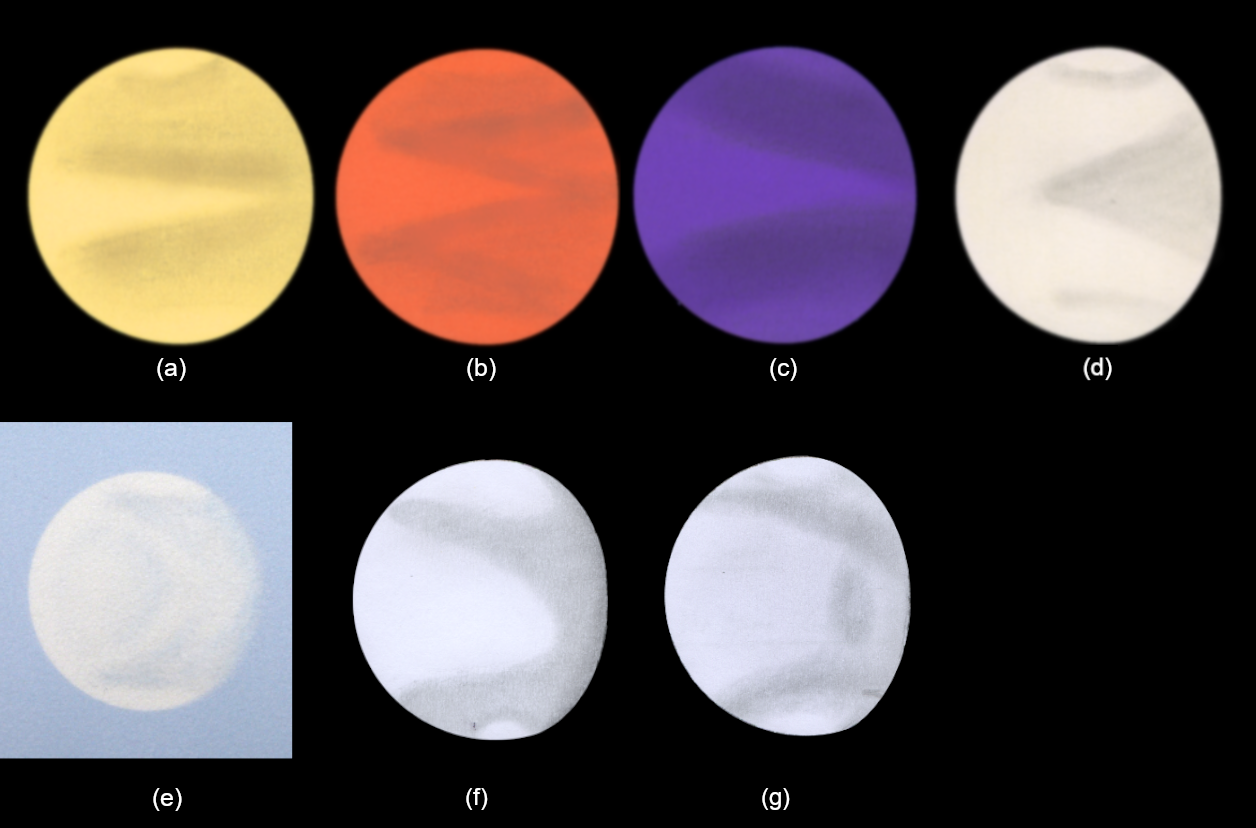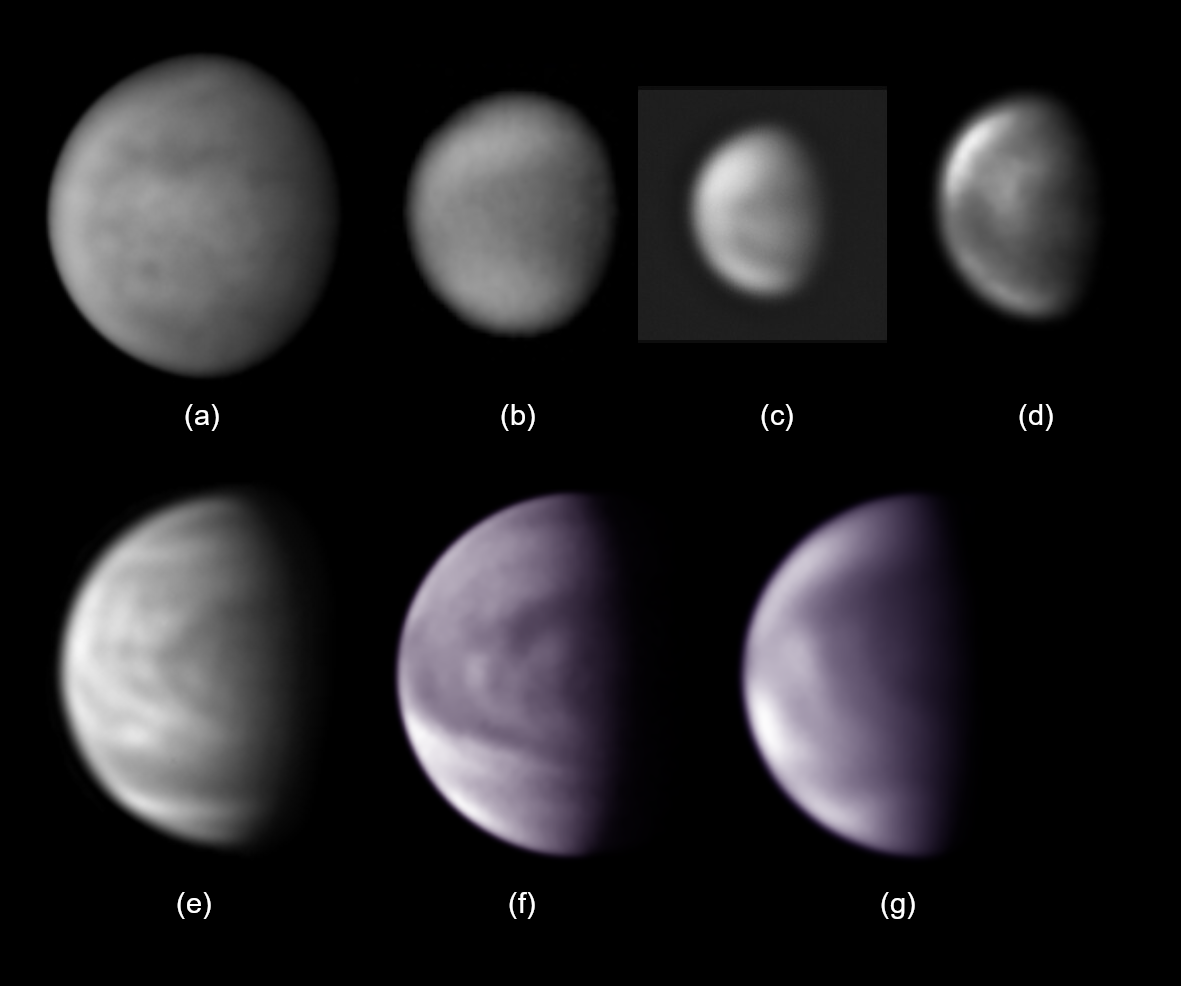The 2021–’22 eastern elongation of Venus
2023 August 10
A report of the Mercury & Venus Section. Director: P. G. Abel
This paper covers observations of Venus made by Section members during the 2021–’22 eastern elongation. Although the planet was a difficult target for many observers, a reasonable number of observations were made, and we present our findings in this report.
Introduction
On 2021 Mar 26, the planet Venus reached superior conjunction on the far side of the Sun. This marked the start of the 2021–’22 eastern elongation which would see the planet once more return to our evening skies. For northern-hemisphere observers, it would be a difficult target due to its very low altitude; conversely, southern-hemisphere observers saw the planet high in the sky.
The synodic period of Venus (i.e., the time it takes to return to the same point in the sky) is eight years, and this is often referred to as the ‘eight-year cycle’. It is useful to compare similar elongations. The eastern elongation eight years previous to this one was the 2013 eastern elongation, and the report covering this was published in the Journal.1
All Section members who contributed observations during this elongation are listed in Table 1. Given the challenges of observing the planet from the UK, the Director was pleased to see that a small number of observers managed to send in reasonable drawings and images during the elongation. Southern-hemisphere observers communicated a number of high-quality images in both IR and UV, while Adamoli and Giuntoli (Italy) contributed frequent drawings with phase estimates. Niechoy (Germany) also sent regular drawings made in integrated light (IL) and a variety of filters.
At the start of the elongation, Venus was at the furthest point away from Earth in its orbit. During this time, the planet had a small apparent diameter and a high phase. Naturally, it is quite difficult to observe at this stage in the elongation. The planet then continued to move towards Earth, and telescopically appeared as waning gibbous. Theoretical dichotomy (at which time Venus should appear 50% illuminated) was predicted for 2021 Oct 28. The planet then continued to move towards Earth, appearing as a large waning crescent.
On 2022 Jan 9, Venus reached inferior conjunction. This marked the start of the 2022 western elongation, and the planet returned to the morning skies once more. In this report we present an analysis of the observations communicated by Section members during this elongation, along with a discussion about the results obtained.

(a) 2021 Jun 8, 11:23 UT; 203mm Newtonian, ×125, W15 filter. (Abel)
(b) 2021 Jun 8, 11:30 UT; 203mm Newtonian, ×125, W21 filter. (Abel)
(c) 2021 Jun 8, 11:36 UT; 203mm Newtonian, ×125, W47 filter. (Abel)
(d) 2021 Jul 16, 10:31 UT; 203mm Newtonian, ×150. (Abel)
(e) 2021 May 7, 17:30 UT; 300mm Newtonian, ×205. (Nuttall)
(f) 2021 Jul 3, 15:15 UT; 203mm Newtonian, ×167. (Giuntoli)
(g) 2021 Jul 10, 16:00 UT; 150mm OG, ×240. (Giuntoli)
Cloud markings & features
The Cytherean atmosphere is very dynamic and images of it in UV reveal rather striking markings. Visual observers who are more sensitive to the bluer end of the electromagnetic spectrum frequently see dusky markings on the planet’s disc.
Both visual observers and imagers recorded some interesting cloud features during the elongation. Figure 1 shows a selection of drawings and the usual cloud markings can be seen. A number of visual observers continue to use filters – these allow them to examine the atmosphere at different depths. Consequently, the cloud markings can change their appearance depending on whether they are being viewed in filtered or integrated light.
Figure 2 shows a selection of UV images taken during the elongation; many of these show complex cloud formations. Note there is also agreement between the images of Figure 2 and the drawings in Figure 1.
It would seem that the remarkable waves recorded in IR observations by a number of observers during the 2015–’20 elongations, and reported by McKim, Abel & Kardasis (2020),2 were absent during this elongation. It is not clear when, or indeed if, this phenomenon will reappear, and so the Director would urge digital observers who frequently image Venus in IR to continue to monitor the planet while it is in its gibbous phase, and to alert the Director as soon as possible if these waves are observed again.

(a) 2021 Jun 15, 16:25 UT; 356mm SCT, ASI 290M, IR 1,000nm. (Morrone)
(b) 2021 Jun 21, 02:30 UT; 203mm Mak–Cass., SKYRIS 132M, Baader U filter. (Hill)
(c) 2021 Jul 31, 14:06 UT; 300mm Cass., ASI 290MM, Astron-U filter. (della Vecchia)
(d) 2021 Aug 4, 02:22 UT; 203mm Mak–Cass., SKYRIS 132M, Baader U filter. (Hill)
(e) 2021 Sep 8, 17:35 UT; 508mm Newtonian, Lucid TRI0515-M, UV false colour. (Miles)
(f) 2021 Sep 22, 08:46 UT; 356mm SCT, ZWO ASI 178MM, Astrodon UVenus. (MacNeill)
(g) 2021 Sep 27, 08:12 UT; 356mm SCT, ZWO ASI 178MM, Astrodon UVenus. (MacNeill)
The terminator
The terminator is the line which marks the division between day and night. On airless bodies like the Moon, this appears as sharp. On planets with substantial atmospheres, like Venus, the terminator is less sharp and is usually accompanied by shading, which gets gradually darker as one approaches the terminator along the dayside. The effect is more evident in photographs and this is one of the reasons why estimating the phase of the planet is easier to do visually than from images.
The ‘cusp terminator anomaly’ (or CTA) as introduced in McKim et al. (2020),2 did not appear in images or drawings made during the elongation. This phenomenon is observed when the planet is in the crescent stage. The Director received very few observations during this part of the elongation, so it is impossible to state definitively that the CTA was absent.
(Log in to view the full illustrated article in PDF format)
| The British Astronomical Association supports amateur astronomers around the UK and the rest of the world. Find out more about the BAA or join us. |
